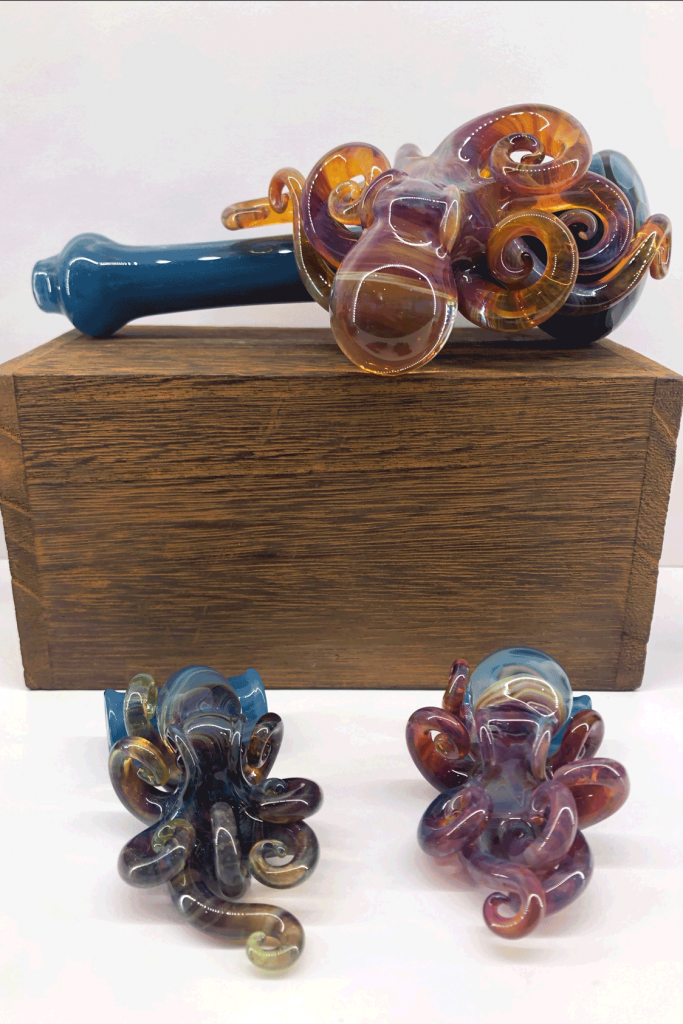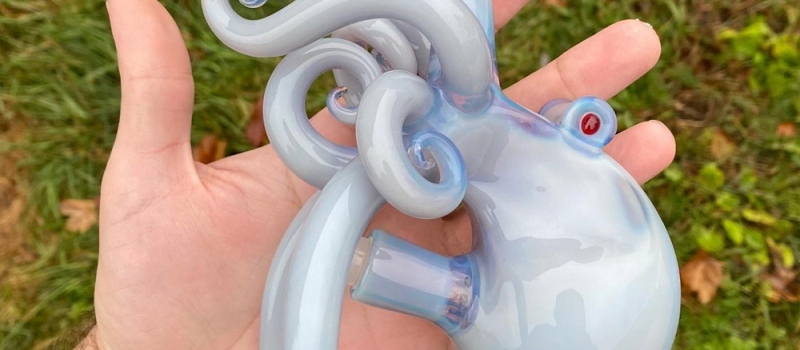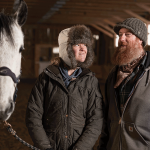B&W: APRIL FEATURE
B&W: APRIL FEATURE
+PIECES OF EIGHT:
Justin Barr and his inspired glass octopuses
WORDS / CYNDLE PLAISTED RIALS
When Justin Barr started searching for what could be his “thing” in glass work, the octopuses actually ended up finding him.
As a 17-year-old fresh out of Windham High School, with no idea what to do with his life, Barr was stoked when his brother signed him up for a glassblowing class. Barr took to it immediately: “I was kinda like a pyro as a kid, so obviously melting down glass is fuckin’ cool. And I liked weed, so it all kinda worked out.” A hearty laugh crinkles his crystalline eyes, which shift blue to green, not unlike the colors in the glass pieces he makes. “I kind of went into it headfirst. I started smokin’, and next thing you know, I’m makin’ pipes. I went in there and he was like ‘What do you wanna learn?’ And I was like ‘I wanna know how to make pipes!’ And he was like ‘Alright, let’s make pipes!’ And that was about it.”
Around that same time, Barr started working toward an anthropology degree. “I got a little ways into it and I was trying to do this [working with glass] at the same time, and I was kinda … failing at both things. So I was like, ‘School can wait.’”
That’s turned out to be a good choice. Barr has spent the last 13 years honing his craft, working in rented studio space at Royal River in Portland for the majority of that time, before the studio closed. When he built his home studio two summers ago — which includes costly items such as customized ventilation, a kiln, and a torch, among other things — it came with some unique perks. “The home studio is next-next level. I don’t usually wear regular pants. I’m usually in pajama pants,” he laughs, gesturing to his worn canvas pants, apparently an anomaly here. They’re likely Carhartt, to match the mustard yellow beanie and thick sweatshirt of the same brand that he wears in the airy studio, with its wide open door looking out on the grassy stretch of field behind his house.


In the early days, he took a class with Mr. Gray, a glassworker of some renown. “During this class, he taught us some techniques involving shears where you’re heating a gather of glass and then cutting it and stretching out the pieces that you cut. And I’m like, ‘Wow, you can really do fuckin’ anything.’ So I ordered a pair of shears and the first thing I made was a tiny little octopus. At the time I was looking for my thing and I was like, ‘Well fuck, if that’s not a thing, I don’t know what is.’ So I never stopped.”
That first pair of shears is the very same pair he still uses to this day. There’s a very good reason for that, and it’s not just the $120 price tag: “These shears gave me a career and a product.” He grips their worn handles, snipping the half-formed blob of glowing glass into the beginnings of eight distinct tentacles. “They really did just kind of give it to me. Inspiration comes in weird ways.”
Barr works with borosilicate glass, different from what is used in traditional “soft” glassblowing; it cools quickly, allowing the artist to work in very fine detail, but necessitating a confident and decisive approach. For those in the know, what Barr does is actually called “lampworking,” a process that originally required a foot-pedaled oil lamp and was used to produce items like beakers and flasks. Some of Barr’s pieces nod to the history of lampworking and weed consumption with familiar shapes we might remember from chemistry class or a first-ever bong rip, because, he says, “A lot of those classical, old-school bong shapes are inspired by scientific glassware. What most people call a beaker is actually an Erlenmeyer flask, but everyone calls that shape of bong a ‘beaker bong.’ I usually make the joke that it’s an ‘Erlenmeyer Bong’ just cuz it’s a funny name.”

That sense of playfulness is evident in Barr’s creations. Through the transformative power of heat and his know-how, two unremarkable rods of glass, one clear and one green, are slowly melded, twisted, and shaped until the familiar form of the octopus emerges. The real magic comes in when the seemingly plain green glass is heated and cooled to specific temperatures. As Barr works the glass, iridescent purples and blues emerge, gliding over the surface of the piece and shimmering in the sun that streams through the window. Barr knows his materials and their capabilities inside and out, a knowledge that allows him to create pieces swirling with color and reflected light — pieces that upon first glance may seem more art than tool.
But he really does want you to use them. “People will tell me, as a sign of respect I think, ‘Oh, man I don’t even think I’m gonna smoke out of it, I’m gonna leave it on the shelf and just admire it as a piece of art.’ And I’m like honestly, bro, smoke out of it, because if you weren’t going to, I wouldn’t have taken all that time to make it a pipe. I would’ve just made you a cool sculpture. So smoke out of it, because it’s a functional thing and part of the art piece is that it’s used. The art isn’t even really complete until you use it, you know?”
That intersection between form and function is a point of particular interest for Barr, who has also harbored an interest in engineering. “I’m a very physical, mechanical-minded person so the engineering component of making functional stuff is cool for me, too,” he says. “And glass is a cool medium just for building things in general. If you know what to do, it can do anything.” For some of his pieces, like the very popular spoons, the octopus is a shimmering adornment to admire as you enjoy your favorite strain of cannabis. For others, like the water pipe, the octopus can become integral to the actual use of the pipe.
From the inspiration to make octopuses in the first place, to the daily work in his studio, allowing the materials and process to guide the creation is a big part of Barr’s approach. “Every octopus comes out different,” he says, “how it ends up sitting on the piece totally determines where the tentacles sit. They’re all one of a kind.” Even where the last tentacle was placed plays a part in where and how the next one curls and flows along the vessel.
Barr holds tight to the flexibility that has gotten him this far: “When it’s not working, you just can’t fight it. I’ve had days where stuff starts exploding and I’m like, ‘What did I do to deserve this?’ you know? Sometimes you just gotta let it win.” Today though, as Barr shapes the intelligent eyes of the cephalopod that has emerged from two rods of plain transparent glass, it’s apparent that his vision is the one that’s winning.
Where can you find us in the wild?
+PUBLISHING SINCE 2021
BECAUSE TASTE MATTERS
With hundreds of breweries and retail cannabis exploding, there’s no need to put just anything in your body. Beer & Weed is about much more than a buzz. It’s about the best, smartest, most innovative brewers and growers and the people who enjoy their products. First Maine and New England, then the world. With your subscription, you’ll get access and insight into the hottest new releases, the best new ideas, and the latest developments in the production of beer and weed. Don’t miss out!



